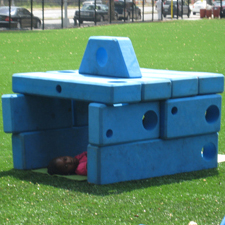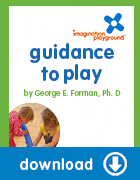The blocks can define the social use of space, such as inside for club members, outside for non-members.
More open enclosures could mean more open membership.

Tall enclosures give children the opportunity to get away from the noise or to deliberately hide and pop out as a game with their peers.

With so many blocks the children can make boundaries for really large areas. While this may be a type of territorial behavior to claim the most space, it could also be part of a game that requires the children to mark the out- of-bounds areas.
What It Means
Children naturally create more intimate spaces within large open spaces to find privacy, or make bounded spaces that define “being in the play” or not. Without the ability to expand or contract these spaces with moveable parts the children would constantly have to accommodate to the size of a jungle gym or the existing sand box. But the moveable parts afford the children an opportunity to negotiate with each other about enlarging the boundaries if the group gets larger or dividing the space if the group gets too mixed, e.g. younger children here, older children there. These boundaries serve as a “memory” for the rules the children create and parts of the laid out spaces give status, such as the cockpit for the pilot versus the spaces behind for the passenger.
2-4 Year Olds
For small children, the whole block defines a space, such as something to stand on or lift. This object can afford social relations with another child as one child invites the other to “do as I do.” The use of the space is defined by the shape and weight of the block.
4-7 Year Olds
Slightly older children will be intrigued with spaces that have a definite inside and outside, or even a my-side and your-side. Even a low wall affords a game of detour and going around the wall. Children understand how their layouts affect the traffic patterns of other children and will make decisions that create structures more and more complex as they play with these blocks.
7-10 Year Olds
As children become more group-oriented their layouts will support social dynamics, such as membership or status. This can be done with full enclosures or even “secret” entry ways that require passwords. While this might seem exclusionary to other children, it could present an opportunity for children to deal with issues of fairness, or at least reasonableness.
This material is adapted from the publication “Imagination Playground’s Guidance to Play” by George E. Forman, PhD, Emeritus Professor, University of Massachusetts (Amherst) and President of Videatives, Inc.
Dr. Forman has over 33 years of experience in university teaching, cognitive research, multimedia design and educational consulting in the area of early childhood learning and development.
“Guidance to Play” covers 20 topics that help illustrate the significance in what children are doing as they play as well as concrete actions Play Associates can take to facilitate positive behaviors.



